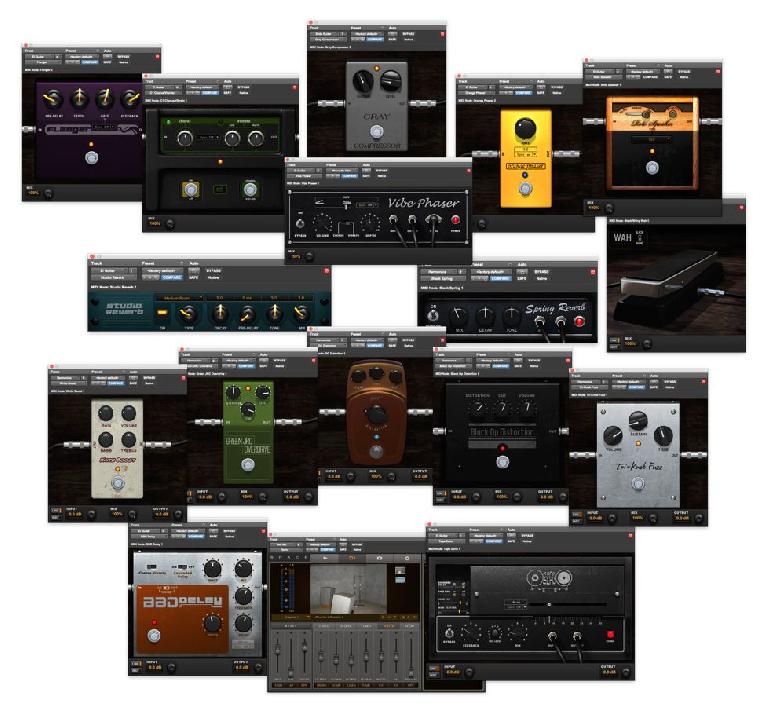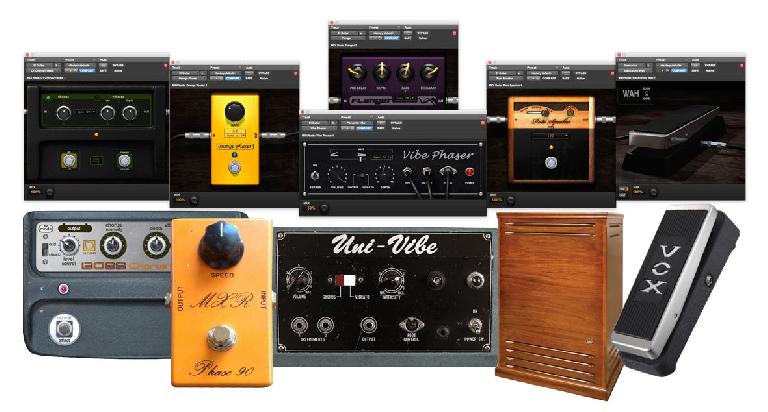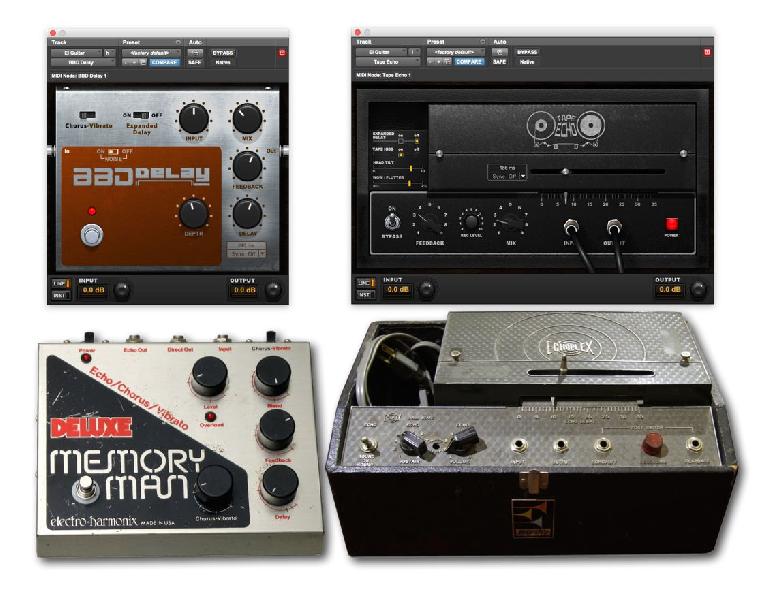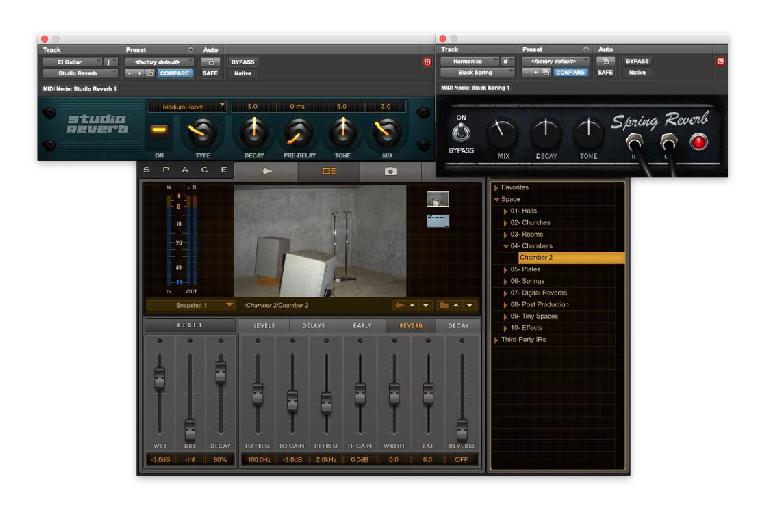As an incentive for Pro Tools users to purchase/renew a Subscription or Annual Plan, Avid has offered a bonus collection of plug-ins for an extra $99. This package consists of 16 effects—emulations of classic stompbox effects & pedals—plus their convolution reverb “Space”. Space has been around for quite a while, but the stompboxes are newly available (outside of Avid’s Eleven Rack hardware, which has included them for some time). Their functions, of course, are straightforward (Chorus, Flange, Distortion, etc), but what may be less obvious is what’s unique about each model. Long-time guitarists may recognize from the graphics which classic hardware piece each plug-in is emulating, and have a pretty good idea of what to expect in the way of specific tonality and appropriate application, but for non-guitarists, and anyone who may not be familiar with the original gear, here’s a brief rundown of these new toys.
Common features
All the stompbox plug-ins have a strip at the bottom, with basic I/O controls. Depending on what’s applicable to the particular effect, they may have an input and output level knob, and a mix knob for easily blending the effect in parallel with the dry signal. Some also feature Line/Inst selector switches, which would seem to be intended to calibrate the signal path through the plug-in to the level of the incoming signal, much as you would with a guitar or other instrument that has a low output level.
As you might expect, switching to Inst adds more gain, pushing distortion effects into greater overdrive, but it also calibrates the plug-in’s output, to pass on the equivalent of a lower-level guitar signal to the next plug-in in the chain. I’d assume the application for this would be if you’re feeding one of these stompboxes into Eleven, or some other amp sim. Avid makes a point of recommending that you calibrate the level of signals coming into Eleven, so the controls will respond as they would on the real amps modeled—the Line/Inst option in the stompboxes would be a way of insuring that the calibrated input level is preserved if you insert one ahead of the amp (as you would in the real world).
Dynamics
The Grey Compressor is a simple affair, just input and output knobs, though the input knob is labelled Sustain rather than Threshold. Remember, the main application of many guitar stompbox compressors was to add sustain to a cleaner signal, but that doesn’t mean that this pedal is only good for that purpose. I tried it on several instruments, including acoustic guitar, where it added a nice push to the signal with a minimum of fuss. The plug-in emulates a Ross compressor, which is kind of a boutique version of the classic MXR DynaComp, another stompbox comp that sounded great on just about everything.
Distortion/Overdrive
There are 5 distortion pedals included that offer up varying levels of crunch. The White Boost models the Xotic RC Booster, another boutique pedal designed to provide clean boost. Of course, in the world of analog pedals, nothing is ever that clean, and the plug-in recreates the gentle overdrive the pedal offers, making it good for thickening up a signal, while boosting the level into an amp sim.
The Green JRC Overdrive models the classic Ibanez TS-808 Tube Screamer, a pedal renowned for its tube-like overdrive, despite the fact that this was provided by a dual op-amp (transistorized) circuit with nary a tube in sight. The “JRC” indicates that the plug-in is emulating the original version of the pedal, which used (Japanese-made) JRC4558 op-amps, as opposed to later versions which substituted different brands, changing the sound (clearly a nod to those who are true stompbox aficionados). The bright, crunchy sound of the original TS-808 is captured nicely here—that pedal is often associated with legendary guitarist Stevie Ray Vaughn, who was said to use it at lower overdrive settings, to dial up some of its characteristic midrange crunch to feed into his amps.
The DC Distortion plug-in doesn’t emulate a specific piece of analog gear—it’s a companion to the generic (but good-sounding) DC Vintage and DC Modern amps in Eleven (and Eleven Free). The plug-in has a nice warm, fat distortion, though tweaking the tone knobs and cranking the drive can take into into heavy distortion, where it still maintains a good midrangy crunch.
Black Op Distortion models the Pro Co Rat, an extremely popular pedal in the 80’s. The original pushed its single op-amp (transistor) into hard-clipping, for a distinctive edgy distortion sound, which, again, is well simulated here.
Finally, Tri-Knob Fuzz takes you from the realm of overdrive and distortion into the rarified atmosphere of the true Fuzz Box, courtesy of its emulation of the classic Electro-Harmonix Big Muff Pi. The original achieved its heavy fuzz tone by driving cascading twin-diodes—4 stages of silicon transistors (as opposed to the older Germanium transistors used in the original version of the equally-classic Fuzz Face). Designed to provide both rich fuzz and singing sustain (thanks to its multi-stage design), the original was used by everyone from Hendrix to David Gilmore (Pink Floyd), and the plug-in emulates that over-the-top fuzz, while still maintaining a (relatively) warm, rich tone.
The 5 distortion effects, in order of increasing distortion (4 bars each): (White Boost, Green JRC Overdrive, DC Distortion, Black OP Distortion, Tri-Knob Fuzz
Modulation
There are also 6 modulation pedals (+ an extra goodie), covering the full range of shimmering, pulsing effects.
The Flanger plug-in—like DC Distortion—doesn’t emulate a particular pedal, but does provide a rich, versatile Flanging effect. Like all the mod pedals (even the emulations), its LFO can be synced to Tempo—a modern convenience (though an expected one in a DAW effect).
C1 Chorus is, not surprisingly, a model of the Boss CE-1 Chorus Ensemble. The original offers one of the most distinctive chorus sounds around, and C1 Chorus does an admirable job of capturing both the Chorus and Vibrato qualities of the real thing.
Orange Phaser obviously emulates the MXR Phase 90—a 4-stage phaser that provides a gentle swoosh which has graced countless recordings since its introduction in the 70’s. The effect is not as deep as some 12-stage phasers, but it does sit well in a track, even a busy one, and would be a good choice when a clean, clear phasing quality is called for.
The Vibe Phaser is based on the Univox Uni-Vibe, a phaser/vibrato that can add a nice shimmer to all sorts of signals. It’s a rich effect, though more subtle then the next offering.
Roto Speaker brings the unmistakeable swirl of the Leslie rotating speaker cabinet (of Hammond organ fame) to not only guitar, but all sorts of tracks that could benefit from its combination of phasing, tremolo, and Doppler effect (vibrato). As you probably know, the spinning horn & woofer of the original cabinet create an effect that used to be impossible to duplicate before the advent of modeling technology. The plug-in includes the standard two speeds of the real Leslie, which, like with all these plug-ins’ controls, can be assigned to a MIDI controller for realtime performance.
There’s also a wah-wah pedal, the Black/Shiny Wah, which puts the modulation of a resonant filter sweep under foot control—or mouse control, or whatever you assign it to via MIDI. It’s modeled after the Vox V846 Wah-Wah pedal, a later version of the classic Vox Wah from the 60’s. Two versions, labelled Black and Shine, emulate different resonant filter characteristics—Shine is a bit peakier.
The 6 modulation pedals, in order (4 bars each): (Dry), Flanger, C1 Chorus, Orange Phaser, Vibe Phaser, Roto Speaker, Black/Shiny Wah (on Shiny)
Delay
BBD Delay channels the Electro-Harmonix Deluxe Memory Man, one of the most popular delay boxes. The original was an analog delay design, which is emulated here—the BBD stands for Bucket-Brigade Delay, which was the method of passing the signal from one analog stage to the next (to the next) to achieve longer delays. This inevitably resulted in signal loss, especially in the highs, and that warm, mellow delay quality is simulated here, for a faithful take on the vibe of the original. Just as with the mod plug-ins, Tempo Sync is offered as well. The effect includes a Chorus-Vibrato option, for a richer sound than just a straight delay, and there’s even a Noise On/Off switch, which I assume is for those who want to include the analog circuit noise of the original unit, for that nth degree of verisimilitude (Avid aren’t the only company to offer this kind of OCD feature, incidentally).
Tape Delay doesn’t cite a specific source of inspiration for its version of an analog tape-based delay, but the graphic unmistakably suggests the Echoplex, the classic tape delay box from the 60’s and 70’s. There’s a wide range of controls for fine-tuning the effect, including Tape Hiss, Head Tilt, and Wow & Flutter, so you should be able to dial up a simulation of any degree of tape-delay quality. In keeping with the original, it includes a (continuous) delay-time dial and a Rec Level control, for adding a bit of modeled tape saturation, to complete the analog vibe.
Reverb
There are two reverbs (three, if you count the also-bundled convolution reverb Space, though I’m just going to cover the stompbox effects). Black Spring is Avid’s version of the vintage Fender spring reverb, which was both included with their amps, and available in a standalone box. As simple as the real thing, it’s not the boingy-est spring reverb sound, but it does capture the metallic ring of those classic ‘verbs—too bad you can’t kick the plug-in (guitarists know what I mean).
Black Spring, a Fender spring reverb emulation
And finally, there’s Studio Reverb, which is based on Avid’s own Reverb One plug-in. It’s a classic digital reverb, with a smooth, warm character, and a good selection of reverb types, and is a nice alternative to the venerable D-Verb.
Of course, there’s also Space, Avid’s convolution reverb, but that would take a whole article to describe, and since it’s been around for a while on its own, I won’t get into it, other than to mention again that it’s part of the optional bundle. And that’s it—a $99 package of some very distinctive, and very useful effects that I was glad to add to my collection of creative plug-ins for Pro Tools work.







 © 2024 Ask.Audio
A NonLinear Educating Company
© 2024 Ask.Audio
A NonLinear Educating Company
Discussion
Want to join the discussion?
Create an account or login to get started!